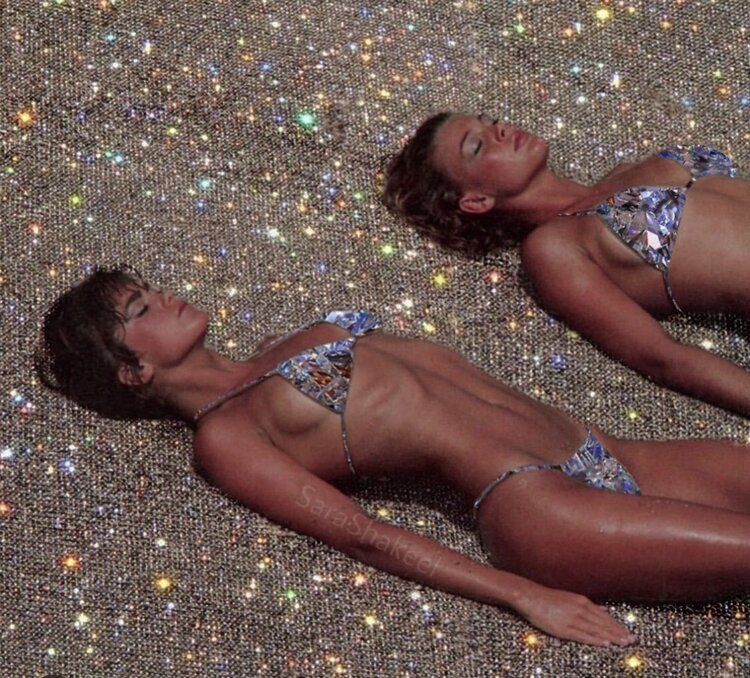
What is sustainable swimwear and is it worth it?
Sustainability and fashion? Is it possible to talk about the two topics together? Do they go hand in hand in practice? Well…. No and Yes. Why both answers? No, because sustainability and fashion are not treated as two interconnected concepts in the present fast fashion module which dominates the whole fashion industry. Yes, because there are extremely creative designers and businesses that are equally passionate about fashion and sustainability; the environmental impact of what they do. In order to further discuss sustainability and fashion one inherent truth must be accepted first. Fashion is a major pollutant and a resource-intensive industry.
Reasons to move towards a sustainable fashion industry
Sustainability is a development that meets the needs of the present without compromising those of the future. So it is obvious looking at fashion trends that change every time a celebrity wears something that looks cool and fashion companies offer an average of 11 collections per year. The current fashion industry is not even close to a sustainable industry. According to Sustain Your Style, ‘The fashion industry is the second-largest polluter in the world’.
The following are some statistics published by the UNEP about the environmental and social costs of your wardrobe.
-
The fashion industry produces 20 percent of global wastewater
-
The fashion industry produces 10 percent of global carbon emissions - more than all international flights and maritime shipping.
-
Textile dyeing is the second-largest polluter of water globally
-
It takes around 2,000 gallons of water to make a typical pair of jeans
-
Every second, the equivalent of one garbage truck of textiles is landfilled or
burned.
-
Textile workers are often paid derisory wages and forced to work long hours in appalling conditions.
The UNEP further explains, if nothing changes by 2050 the fashion industry will use up a quarter of the world’s carbon budget.
We have come to a point where whether climate change is happening is not a question anymore. Climate change is happening and it is a fact. The question now to be asked is whether climate change is reversible. According to NASA even if carbon emission is stopped, global warming will continue to increase for a few decades or even centuries. Does that mean that we are too late now? No, fortunately as we are capable of using two main mechanisms to respond: 1) mitigation - reducing the flow of greenhouse gases into the atmosphere and 2) adaption - learning to live more consciously, and adapt to, the climate change that has already been set in motion.
So do you still think a fast fashion module is an option? We have to and we must move towards a more sustainable, responsible fashion industry.
What is sustainable swimwear? - difference between sustainable swimwear and traditional swimwear - environmental impact
Selecting the best comfortable swimwear does play a great deal when it comes to spending your summer vacation in style. So the fabric of your swimwear matters a lot. That’s when Nylon and Polyester come into the play. These two fabrics are the most popular fabrics used for swimwear by the majority of the swimwear brands. Nylon and Polyester are known as “tough materials” as they can go easy with constant body movements, and are resistant to shrinkage, which is obviously necessary for the use in water.
But what is the problem with Nylon and Polyester? Both of these fabrics are made from synthetic material, which means they are derived from petroleum oil. That means they do not biodegrade and will take decades to break down. To add to that the process of extraction and production of fibers contributing to the emission of greenhouse gases as well.
According to The Guardian, researchers at the University of California found out that on average, synthetic fleece jackets release 1.7 grams of microfibers each wash. They further observed that older jackets shed almost twice as many fibers as new jackets. Synthetic clothes shed microfibers when washed causing pollution to our waterways. So think about the number of microfibers that are released into the ocean every year. Microfibers washed off from products such as synthetic clothes contribute up to 35% of the plastics that cause ocean pollution.
What is sustainable swimwear? Fortunately, with the advancement of the technology in regenerated and recycled materials sustainably produced comfortable, stylish swimwear with a sense of luxury can be found in the market under many brand names without much effort. What is recycled swimwear made of?
A bikini made by recycled materials has a lesser impact on the ecosystem than a bikini made using new synthetic materials. There are two plus points of a bikini made by recycled fabric; Firstly the natural resources that would have been used to make a bikini using new materials are saved. Secondly, the waste that otherwise would end up in a landfill is used again and given another life. Recycled fabrics are produced using waste such as discarded fishing nets, used carpets, nylon included clothing, recycled plastic bottles, etc.
Sustainable fabrics used for swimwear- production process - different types of fabrics - features of fabrics
Fabrics produced using recycled materials are not any less in quality or comfort owing to the improved yet responsible production process.
ECONYL is regenerated nylon produced using nylon-based waste such as fishing nets, used carpet flooring, fabric waste, and industrial plastics collected from landfills and oceans around the world. The waste is cleaned and sorted to get the maximum amount of nylon. ECONYL uses an advanced regeneration and purification process which goes beyond recycling to return the recycled fabric to its original purity. This means that ECONYL regenerated nylon is exactly the same virgin raw nylon with high performance. The regenerated nylon is then processed to be textile yarn and carpet yarn to be used in fashion and interior industries. Fashion brands and carpet producers use ECONYL for their products and the amazing thing is that the regenerated nylon can be recycled infinitely without losing its quality. So once the products contain ECONYL, the material can go to the first step of the regeneration process without producing waste. It is one of the best sustainable brands for fabrics popular among designers. Every 10,000 tons of ECONYL material produced, stops emission of 57,100 tons of carbon dioxide to the atmosphere, and 70,000 barrels of crude oil from being used.
Vita by Carvico is a sustainable techno-fabric made using ECONYL regenerated nylon. Vita is a famous choice for sustainable swimwear fabric thanks to the great features compared to the fabrics of its competitors. Those features are ultra-chlorine resistant, resistant to sunscreen and oil, muscle control, shape retention, ultra-flat, soft, two-way stretch, pilling resistant, perfect fit, and extra comfort.
Renew Cult by Jersey Lomellina is a sustainable fabric made using ECONYL regenerated nylon. Some features of Renew Cult by JL are recycled yarn, high performance, pilling resistant, perfect fit in constant body moves, two-way stretch, UV protection, excellent coverage, quick-drying, breathable, soft.
Amni Soul Eco Thread has created the world’s first recyclable and biodegradable polyamide yarn. The quality of the yarn is similar to that of its competitors but will biodegrade into organic matter and biogas in a landfill environment within 5 years when the other polyamide yarns are not biodegradable.
REPREVE is one of the most trusted performance fibers made using recycled materials including plastic bottles. The advanced transformation process of recycled materials to performance fiber makes it reliable and durable.
More reasons to choose sustainable swimwear - comfort, style, high quality in a more responsible manner
Are swimwear produced using sustainable fabrics no different from conventional swimwear? That depends on the sustainable fabric used. When selecting fabrics for swimwear designers pay a great deal of attention to comfort. Swimwear is expected to be comfortable when you are in it and must let you feel great. Choosing the sustainably made best bikini for your summer vacation needs some time and attention as there are hundreds of great designs by top sustainable swimwear brands to choose from. Swimwear by the majority of the top sustainable swimwear brands has timeless designs that you can use for more than one vacation. So just because you go for a sustainable option you won’t have to compromise style. Another plus point for sustainable swimwear is the fabric is durable, focusing to be used for a longer period compared to a low-quality conventional bikini you would not be able to use again next summer.
Here is a list of top sustainable swimwear brands in 2020
VITAMIN A, founded in 2000 by Amahlia Stevens is one of the first sustainable swimwear brands which thrives in the sustainable swimwear market. Vitamin A is a combination of feminine design with sustainable innovation inspired to create effortless, natural sexiness, and that laid-back West Coast vibe. They use Ecolux fabric made from recycled nylon for their bikinis and bodysuits that are produced locally in California. They donate a portion of their proceeds to environmental organizations that work to save our oceans.
Bromelia is a top sustainable swimwear brand from Brazil. Bromelia uses Econyl for their swimwear and is specialized in tropical prints and simple cuts. The label works with women to ensure each of its pieces is designed and handmade on home turf.
Frankies Bikinis is a Los Angeles-based top sustainable bikini brand that uses fabric by Amni Soul Eco for its classic black and houndstooth bikinis and one-pieces.
Sensi Graves is a US-based sustainable swimwear brand dedicated to creating comfortable, performance level suits. The brand uses Econyl or Repreve (a performance fiber made from plastic bottles)
Reformation is a top sustainable swimwear brand that uses Econyl for their swimwear collection. The prints take the label to another level, using tie-dye, leopard, pretty wallpaper florals, and many more eye-catching designs.
BOLD Swim is a sustainable swimwear brand that takes sustainable practice seriously. Their size-inclusive swimwear is made using Amni Soul Eco Thread and CO2 Light Fabric. Bold Swim only uses non-toxic dyes for their suits and upcycled fabric waste from production to create rugs and mats by local artists in Brazil.
Bower is a sustainable luxury swimwear label that uses Econyl for their products. The brand is focused on minimizing waste, so they purposely create collections in small quantities.
Mara Hoffman is famous for her sustainable swimwear line; signature suits made using Econyl or Repreve.
Ohoy Swim is an Econyl based swimwear brand manufactured by a small, family-run factory in Sri Lanka. Carefully made simple pieces of Ohoy Swim have timeless styles. The company spends a great deal of time ensuring the working condition of its staff and they donate a percentage of their sales to Healthy Seas.
Saturday Swimwear US-based women-owned handmade swimwear brand. The designer and the owner of the label, Emily Laplume who travels across the country by van sews each and every suit. Saturday Swimwear uses a durable fabric made from a blend of Econyl and LYCRA XTRA LIFE. Her packaging is plastic-free with the great attention given to every step of the production and she uses biodegradable and compostable materials for their packaging.
Medina is an Econyl based swimwear brand with a “waste-to-wear” policy. Every material is used for their sustainable one of kind designs.
With all of these great options, what will you be your favorite responsibly produced swimwear?
References
10 Sustainable Swimwear Brands To Get To Know Now. British Vogue. (2020). Retrieved 2 July 2020, from https://www.vogue.co.uk/fashion/gallery/sustainable-swimwear-brands.
Ethical, Eco-friendly, & Sustainable Swimwear. Mygreencloset.com. (2020). Retrieved 2 July 2020, from https://mygreencloset.com/eco-ethical-swim-brands/.
High-quality performance fabrics | Carvico and JL. Carvico. (2020). Retrieved 2 July 2020, from https://www.carvico.com/en/performance-fabrics/.
Is it too late to prevent climate change? – Climate Change: Vital Signs of the Planet. Climate Change: Vital Signs of the Planet. (2020). Retrieved 2 July 2020, from https://climate.nasa.gov/faq/16/is-it-too-late-to-prevent-climate-change/.
Make it feel right. Makeitfeelright.com. (2020). Retrieved 2 July 2020, from https://www.makeitfeelright.com/about.
REPREVE® | Made From Recycled Plastic Bottles. #TurnItGreen with REPREVE®. (2020). Retrieved 2 July 2020, from https://repreve.com/discover.
Tencel.com. (2020). Retrieved 2 July 2020, from https://www.tencel.com/news-and-events/comfortability-and-sustainability-are-taking-the-lead-in-lingerie.
The best sustainable swimwear brands. Harper's BAZAAR. (2020). Retrieved 2 July 2020, from https://www.harpersbazaar.com/uk/fashion/what-to-wear/g27451403/best-sustainable-swimwear-brands/.
The fashion industry emits more carbon than international flights and maritime shipping combined. Here are the biggest ways it impacts the planet... Business Insider. (2020). Retrieved 2 July 2020, from https://www.businessinsider.com/fast-fashion-environmental-impact-pollution-emissions-waste-water-2019-10#in-europe-fashion-companies-went-from-an-average-offering-of-two-collections-per-year-in-2000-to-five-in-2011-3.
The Process. Econyl. (2020). Retrieved 2 July 2020, from https://www.econyl.com/the-process/.
Messinger, L. (2020). How your clothes are poisoning our oceans and food supply. the Guardian. Retrieved 3 July 2020, from https://www.theguardian.com/environment/2016/jun/20/microfibers-plastic-pollution-oceans-patagonia-synthetic-clothes-microbeads.
Project Findings. Microfiber Pollution & the apparel industry. (2020). Retrieved 3 July 2020, from https://brenmicroplastics.weebly.com/project-findings.html.



